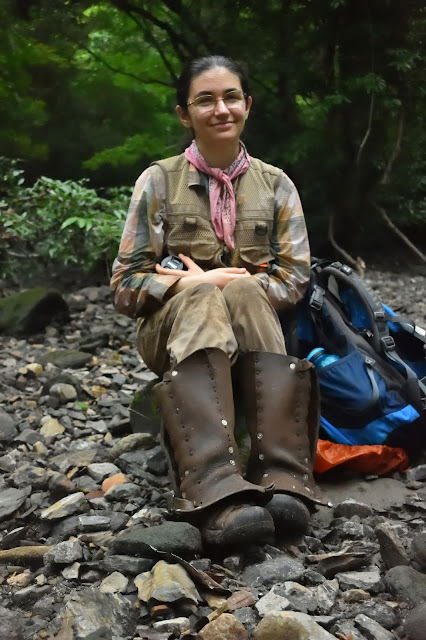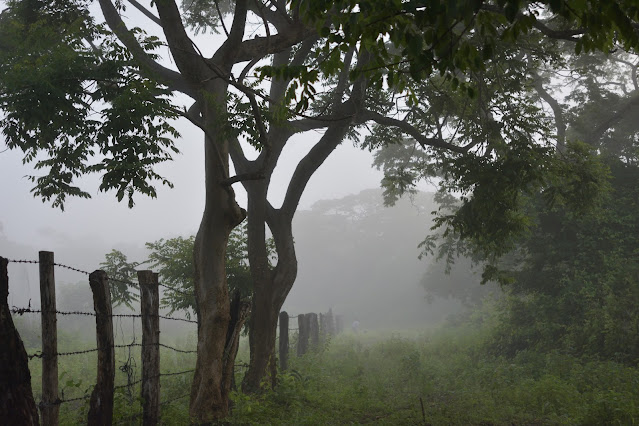Day in the Life Part 1
 |
| Field fashion. Photo: A. Duchesneau. |
The alarm goes off at 3:45 am. I jolt upright, catching my head in the flimsy mosquito netting overhead, then scramble out of my top bunk onto the floor. My mom is already up and about; I can hear her opening the fridge and chatting with the other assistants in the kitchen. I walk over to our makeshift plywood shelving and begin pulling on my field clothes: long, baggy army surplus pants, a lightweight flannel shirt, a fishing vest to store equipment in, heavy wool socks, and a bandanna, which I tie around my neck. I unplug my camera battery, which has been charging overnight, and stow the camera in the deep recesses of my hiking backpack, along with three one-liter water bottles that I filled the night before. Then I head out to the kitchen to get a glass of orange juice and a banana—I can’t stomach much more than that at 4 in the morning (click the link to learn more about the monero schedule!). As usual, the kitchen is already bustling with people: Jamie rushes past looking for his data tablet, Odd is searching the fridge for his lunch, and Fiona is drinking a cup of coffee at the kitchen table.
I chug my orange juice and just barely remember to retrieve my own lunch—a tupperware full of last night’s bean stew—from the fridge. Then I shoulder my backpack and trudge outside to the front porch, where I sit down on one of the rocking chairs and begin pulling on my hiking boots. In addition to the boots, all moneros wear polainas—thick leather snake guards made for us by the local talabateria, or leather store. Polainas start out supple and clean, with gleaming metal buckles, but most of ours are now scratched and stiff from years of use. This morning I am tired enough to buckle them on the wrong feet the first time around, and I am still re-doing them as everyone else begins to file towards the car. Finally, I secure the last buckle, dump my backpack in the trunk, and squeeze in next to Fiona in the back seat of the car.
 |
| Bucket of polainas (snake-leggings). Photo: K. Perry |
Odd, our designated driver, connects his iPhone to the portable speaker set that we have jammed between driver and passenger seats (the car radio is long gone). We trundle out of Bagaces, the small town where we live, and onto the Pan-American highway, the music blasting through our open windows, which are rolled down to catch the nighttime breeze. Some of us try to catch a few more precious minutes of sleep, our heads lolling and jerking to the rhythm of the Pan-American’s potholes and Odd’s playlist. Others murmur song lyrics, or stare out the window at the stars.
After a few miles, we turn off the main highway onto the access road to the Pelon ranch, which produces a good deal of the rice supply in Costa Rica. Monkeys, unfortunately, do not restrict themselves to the confines of their reserve, and the Pelon ranchers have graciously allowed us to follow them whenever they stray beyond its bounds.
 |
| Moneros on the walk back from the Bees' Boxes sleep site (it's too dark to take these pictures in the morning!). Photo: S. Perry |
The ground at the top of the hill is littered with rusted metal, a relic of the bee boxes that used to sit here. A little way through the trees is a convenient fallen log, soft and mossy, but not yet so rotten that it cannot hold our weight. I shrug off my backpack and sit down, then squint at the trees on the edge of the hill, black against the quickly lightening sky. Jamie passes around bug spray—a cloud of mosquitoes is already gathering hopefully at our feet.
 |
| How many monkeys do YOU see waking up? Photo: K. Perry |
Suddenly, I hear a rustle in the trees to our right and look up to see a small black shape scamper down a branch. The monkeys are waking up. Soon, two juveniles are chasing each other through the branches, and the air is full of the peeps, twitters, and occasional screams of monkey society in full gear.
It is still too dark to make out individuals, so we merely keep the group in our line of vision as they make their noisy, spastic way downhill. A fight breaks out briefly, and my mom takes out her binoculars, trying to identify the tangle of black shapes overhead, but it is hopeless. Gradually the group moves back uphill, looking for breakfast.
We clamber out of the undergrowth and station ourselves under a mora tree at the edge of the pasture-line, watching the branches below us shake as hungry monkeys sprint towards us. The first monkey to emerge into the sunlight is Avocado, one of the juvenile males. He grabs fistfuls of the green mora fruits and shoves them in his mouth, making little food peeps that mean “this is my food.” For a while he munches happily, then pauses to glower out across the pasture, a bit of mora pulp hanging from his bottom lip. He has a particularly clownish face, and right now, with his brows contorted and one of his canines protruding, he looks like a rather fluffy gargoyle.
 |
| Avocado, our resident gargoyle, defending his mora fruit from attack. Photo: K. Perry |
“Handle fruit mora, ingest. Handle fruit mora, ingest, ingest. Handle fruit mora, drop. Handle fruit mora, ingest,” Susan narrates as Jamie and Fiona practice typing on their tablets. Soon Avocado abandons the mora tree and dives back down the hillside, sending us all scrambling after him. He bounds up to Bedlam, one of the other juveniles, and play pounces on him, sending them both rolling across the forest floor. “Receive play bite Bedlam, focal play wrestles Bedlam, receive play hit Bedlam,” Susan narrates, whipping out her Dictaphone and beginning to record. It is hard to type all the action of a play follow in real time. “Receive approach to five and one Ybobo, receive play pounce Ybobo, focal play wrestles Ybobo—no, Bedlam, sorry—” All three monkeys are now a single writhing ball on the ground, with only the occasional limb waving frantically above the melee. If you listen closely enough, you can hear them making soft panting sounds—the closest capuchins come to laughter. “Focal play flees Ybobo, focal leaves one Ybobo and Bedlam, focal leaves five Ybobo and Bedlam—phew, that’s it,” Susan says, as her stopwatch goes off, signaling the end of the follow. “Focal is in social play, in ten of Ybobo and Bedlam, in five of Mikumi.”
 |
| Avocado at play with other juvenile males (Mikumi is at far left) Photo: K. Perry |
Mikumi, the alpha male of Celeste’s, is sitting on a log nearby, munching on a grasshopper. We turn our attention to him next.
 |
| Mikumi after finishing his grasshopper. Photo: K. Perry |

Comments
Post a Comment